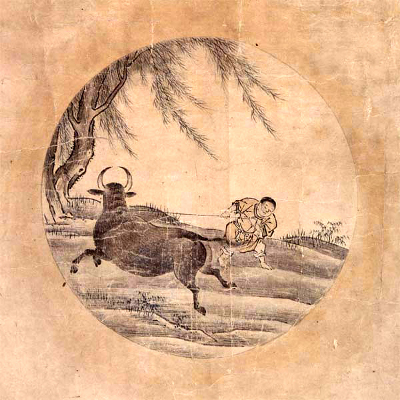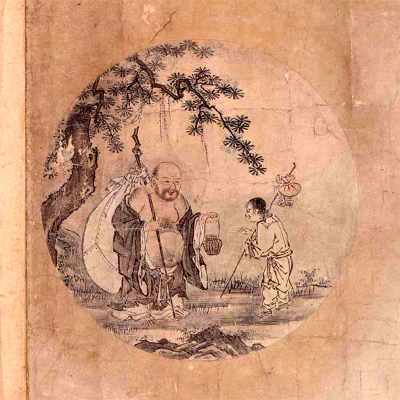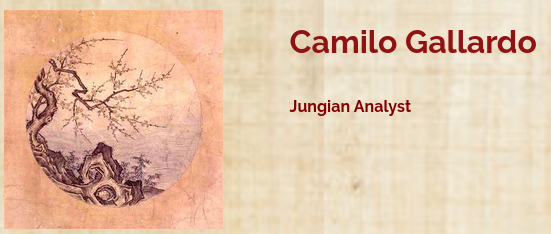10 Oxherd Pictures
Let us now turn to the Oxherding Pictures, Zen’s counterpart to the Rosarium pictures and an itinerary, so to speak, to the Zen experience of mortificatio. Although to be accurate, it should be said, as is the case with the Rosarium pictures, the Oxherding Pictures are not just about death.
They are about death and rebirth. It must be emphasized that the Oxherding Pictures are ultimately about being reborn into a life that is lived with the living knowledge of empty oneness. It is not just about the initial enlightenment experience or awakening to empty oneness, i.e., satori, which is usually a peak experience that settles, but about the practical life one has to then lead in the aftermath of that experience and integrating that experience. Seeing emptiness is thus only the beginning; leading a life in accord with emptiness is another matter, and the true goal of Zen.
To begin, I should say, firstly, that what I will present to here is a very brief sketch, without the commentary and poetry that accompany each picture. For those of you interested in a fuller treatment, D.T. Suzuki’s writings may be considered a primary source, and Marvin Spiegelman and Mokusen Miyuki also provide an interesting treatment of these pictures in their book Buddhism and Jungian Psychology.
Secondly, there is more than one set of the Oxherding Pictures, each with its own unique advantages. I will tonight use the set that has gained the widest acceptance today, the set attributed to the 12th century Chinese Zen master Kuo-an Shih-yuan, or Kakuan Shien in Japanese. Moreover, I will use a modern version of it in the form of ink-and-brush paintings by Gyokusei Jikihara (available at http://www.mro.org/zmmold/zenarts/oxherdinggallery.html).
Earlier sets in China show the ox gradually turning from black to white, signifying that the ultimate goal of Zen is the realization and increasing integration of emptiness. The gradual quality of this speaks to the Soto school’s emphasis on gradual enlightenment, as opposed to the sudden enlightenment of the Rinzai school of Zen. In Jungian language, one could say that this whitening represents a progressive diminishment of shadow, shadow not in the sense of personal or archetypal shadow, but simply in the sense of what the ego does not see in regard to enlightenment. Also, other sets present each picture as a circle within a square, suggesting that the Unconscious or Self must be integrated into consciousness—a principle known in alchemy, with some subtle variations in nuance, as “squaring the circle.”
Let’s look at the first picture. It is called “Seeking the Ox.” The ox represents the seeker’s true nature, that is, Buddha nature or Buddha-mind, the Self. It is probably because of the ox’s sacred nature in ancient India that it came to symbolize man’s primal nature or Buddha-mind. The oxherder here, however, knows himself only as small mind, as an ego. He sets out in search of enlightenment, but in fact, his original nature has never gone astray—he just can’t see it. What blocks enlightenment are the defilements of the ego—its desires, fears, and delusions of duality. As the Hindu sage Meher Baba said, “The ego sees what is not there, and does not see what is there.” But herein lies the paradox: If the oxherder doesn’t see the ox, how does he know it even exists? How does he even know to seek it? It is the Self from the very beginning that seeks itself, that inspires the urge to realisation. The whole process occurs under the auspices of the Self.
Let us go to Picture Two. Entitled “Finding the Tracks,” it is fairly self-explanatory. Basically, in this picture, Dorothy is on the Yellow Brick Road to Oz. At least on an intellectual level, the ego knows that there is such a thing as the Self, similar to the early phase of analysis in which the patient is seeking and trusting that something will help him or her but does not know what it is.
Turning to the third picture, it is called “First Glimpse of the Ox.” This picture indicates the threshold of satori, the point at which one- pointedness of mind is so strong and clear that there are real hints of Buddha nature. Enlightenment is glimpsed, but not yet fully crystallized and experienced. This is a peculiar, in-between state, and often the Zen practitioner thinks he or she has realized emptiness when in fact he or she is perceiving it, as the picture illustrates, in an obscured way.
Picture Four is called “Catching the Ox.” It celebrates the experience of satori, enlightenment. Emptiness is clearly perceived and apprehended by consciousness. But it is not yet fully comprehended, not yet integrated into everyday life. Grasping emptiness is thus tantamount to realization, but not actualization, at least not as of yet. The aim of Zen is to embody emptiness in one’s daily existence. This picture marks the culmination of the initial phase of Zen training.
Picture Five is “Taming the Ox,” the beginning of working with one’s realization in a practical, applied way. It portrays the struggle to integrate empty oneness into everyday life. One wrestles with one’s thoughts and desires. But even they arise from Buddha nature, and it is only because the delusions of the ego still persist that they are imagined to be real. The process of working through this subjective state of delusion is undertaken via the study of the Mumonkan, the 48 koans that comprise the main text of Zen training.
Picture Six is “Riding the Ox Home.” Kakuan’s commentary tells all: “The struggle is over, ‘gain’ and ‘loss’ no longer affect [the oxherder]. He hums the rustic tune of the woodsman and plays the simple songs of the village children. Astride the Ox’s back, he gazes serenely at the clouds above. His head does not turn [in the direction of temptations]. Try though one may to upset him, he remains undisturbed.”
Picture Seven is called “Ox Forgotten, Self Alone.” The term “Self” here refers to the Self-realized ego. At this stage, the relations between the ego and the Self are transcended. “Self” is no longer other, and what occurs now and henceforth is beyond such dualistic relations, beyond “betweenness.” The oxherder has embodied emptiness; he has, so to speak, made it his own. If the first six pictures are about the relations between the ego and the Self, the latter four represent the movement toward sheer emptiness, first without an awareness of the Self as other, and then, as we shall see in the next picture, without even an awareness of oneself as the embodiment of emptiness, for any such awareness can only be from a distance and hence a form of separation from empty oneness.
Picture Eight, “Both Ox and Self Forgotten,” is then true empty oneness. Even the act of emptying and the sense of emptiness have been thrown out. Now that’s really empty! The ego has been bottomed out, and only the bottomless Void remains. Of this end to egocentricity, Kakuan writes, “If hundreds of birds were now to strew flowers about [the oxherder’s] room, he could not but feel ashamed of himself.” What a humility and “poverty of spirit”—as the Christian mystics call it—this statement reveals. In Zen, there are three levels of enlightenment or emptiness. The first is dropping off body and mind. Pictures One to Seven correspond to this. The second level is dropping off dropping body and mind. This corresonds to Pictures Eight and Nine. And the final picture is dropping off dropping off. Picture Eight here denotes the peeling process that razes the ego down to nothingness. Notice its resemblance to the ouroboros—the primal beginning, infinity, but also death. [Click to: http://en.wikipedia.org/wiki/Ouroboros ] To give up not only the attachments of the body and mind but even the attachment to the rewarding feeling of giving up involves a real mortificatio. As Bob Dylan sings, “When you think that you’ve lost everything, you find out you could always lose a little more. . . . I close my eyes and wonder if everything is as hollow as it seems.”18
Picture Nine is called “Returning to the Source.” Here the oxherder is simply what is. He has returned to the origin of all, not in any particular form or state of distinctness, but simply as what naturally exists in the form of life itself, just as it is. As he nears the final stage of his Zen journey, he finds himself back at the beginning, but with a new consciousness. This process is conveyed in the Zen saying that Donovan made famous when he sang, “First there is a mountain, then there is no mountain, then there is.”
One sees the world, then one realizes one does not see the world, then one sees the world. And seeing the world exactly as it is, endlessly changing and with nothing to strive for, including enlightenment, the oxherder is able to fully yet selflessly enter it.
Picture Ten is thus called “Entering the Market With Helping Hands.” The summum bonum of the Zen process of death and rebirth, it reflects individuation as Jung himself understood it: the oxherder, here transfigured into the jovial or laughing Buddha, is an in-dividual in the sense that he is undivided not only within himself but from the world. Unlike the yogi who remains in his cave in permanent retreat from the world, or the Hinayana Buddhist monk who must be a saintlike paragon of virtue, the Zen bodhisattva returns to the world, inhabiting it now as easily as he dwelled in his hut in Picture Seven. Zen teaching warns against sinking into an emptiness or enlightenment that becomes static, that hasn’t dropped off dropping off. “True Zen does not smell of Zen,” the sages tell us, by which they mean it does not smell of enlightenment or some kind of lofty sanctity. True Zen is ordinary, not extraordinary. Chop wood, carry water, see patients. In ancient China, gourds were commonly used as wine bottles, signifying in this picture the enlightened man’s ordinariness as opposed to otherworldliness. The Zen master then is a free spirit who un-self- consciously embodies empty oneness and can go anywhere, bringing his ordinary Zen into the world, partaking in the community and marketplace, and helping his fellow human beings live in the Way of the Buddha simply by virtue of his own example.
Michael Gellert
****
This is one of a series of ten images, generally known in English as the Ox-herding (or Bull-herding) pictures, by the 15th century Japanese Rinzai Zen monk Shubun. They are said to be copies of originals, now lost, traditionally attributed to Kakuan, a 12th century Chinese Zen Master.
The following is adapted from the preface by Nyogen Senzaki and Paul Reps to the first edition of their translation.
"Zen Flesh, Zen Bones, A Collection of Zen and Pre-Zen Writings"
Copyright by Charles Tuttle and Co.
The bull is the eternal principle of life, truth in action. The ten bulls represent sequent steps in the realization of one's true nature. http://www.iloveulove.com/spirituality/buddhist/tenbulls.htm

1. The Search for the Bull
In the pasture of this world, I endlessly push aside the tall grasses in search of the bull.
Following unnamed rivers, lost upon the interpenetrating paths of distant mountains,
My strength failing and my vitality exhausted, I cannot find the bull.
I only hear the locusts chirring through the forest at night.
Comment: The bull never has been lost. What need is there to search? Only because of separation from my true nature, I fail to find him. In the confusion of the senses I lose even his tracks. Far from home, I see many crossroads, but which way is the right one I know not. Greed and fear, good and bad, entangle me.

2. Discovering the Footprints
Along the riverbank under the trees, I discover footprints!
Even under the fragrant grass I see his prints.
Deep in remote mountains they are found.
These traces no more can be hidden than one's nose, looking heavenward.
Comment: Understanding the teaching, I see the footprints of the bull. Then I learn that, just as many utensils are made from one metal, so too are myriad entities made of the fabric of self. Unless I discriminate, how will I perceive the true from the untrue? Not yet having entered the gate, nevertheless I have discerned the path.

3. Perceiving the Bull
I hear the song of the nightingale.
The sun is warm, the wind is mild, willows are green along the shore,
Here no bull can hide!
What artist can draw that massive head, those majestic horns?
Comment: When one hears the voice, one can sense its source. As soon as the six senses merge, the gate is entered. Wherever one enters one sees the head of the bull! This unity is like salt in water, like color in dyestuff. The slightest thing is not apart from self.

4. Catching the Bull
I seize him with a terrific struggle.
His great will and power are inexhaustible.
He charges to the high plateau far above the cloud-mists,
Or in an impenetrable ravine he stands.
Comment: He dwelt in the forest a long time, but I caught him today! Infatuation for scenery interferes with his direction. Longing for sweeter grass, he wanders away. His mind still is stubborn and unbridled. If I wish him to submit, I must raise my whip.

5. Taming the Bull
The whip and rope are necessary,
Else he might stray off down some dusty road.
Being well trained, he becomes naturally gentle.
Then, unfettered, he obeys his master.
Comment: When one thought arises, another thought follows. When the first thought springs from enlightenment, all subsequent thoughts are true. Through delusion, one makes everything untrue. Delusion is not caused by objectivity; it is the result of subjectivity. Hold the nose-ring tight and do not allow even a doubt.

6. Riding the Bull Home
Mounting the bull, slowly I return homeward.
The voice of my flute intones through the evening.
Measuring with hand-beats the pulsating harmony, I direct the endless rhythm.
Whoever hears this melody will join me.
Comment: This struggle is over; gain and loss are assimilated. I sing the song of the village woodsman, and play the tunes of the children. Astride the bull, I observe the clouds above. Onward I go, no matter who may wish to call me back.

7. The Bull Transcended
Astride the bull, I reach home.
I am serene. The bull too can rest.
The dawn has come. In blissful repose,
Within my thatched dwelling I have abandoned the whip and rope.
Comment: All is one law, not two. We only make the bull a temporary subject. It is as the relation of rabbit and trap, of fish and net. It is as gold and dross, or the moon emerging from a cloud. One path of clear light travels on throughout endless time.

8. Both Bull and Self Transcended
Whip, rope, person, and bull -- all merge in No-Thing.
This heaven is so vast no message can stain it.
How may a snowflake exist in a raging fire?
Here are the footprints of the patriarchs.
Comment: Mediocrity is gone. Mind is clear of limitation. I seek no state of enlightenment. Neither do I remain where no enlightenment exists. Since I linger in neither condition, eyes cannot see me. If hundreds of birds strew my path with flowers, such praise would be meaningless.

9. Reaching the Source
Too many steps have been taken returning to the root and the source.
Better to have been blind and deaf from the beginning!
Dwelling in one's true abode, unconcerned with that without --
The river flows tranquilly on and the flowers are red.
Comment: From the beginning, truth is clear. Poised in silence, I observe the forms of integration and disintegration. One who is not attached to "form" need not be "reformed." The water is emerald, the mountain is indigo, and I see that which is creating and that which is destroying.

10. In the World
Barefooted and naked of breast, I mingle with the people of the world.
My clothes are ragged and dust-laden, and I am ever blissful.
I use no magic to extend my life;
Now, before me, the dead trees become alive.
Comment: Inside my gate, a thousand sages do not know me. The beauty of my garden is invisible. Why should one search for the footprints of the patriarchs? I go to the market place with my wine bottle and return home with my staff. I visit the wine shop and the market, and everyone I look upon becomes enlightened.
